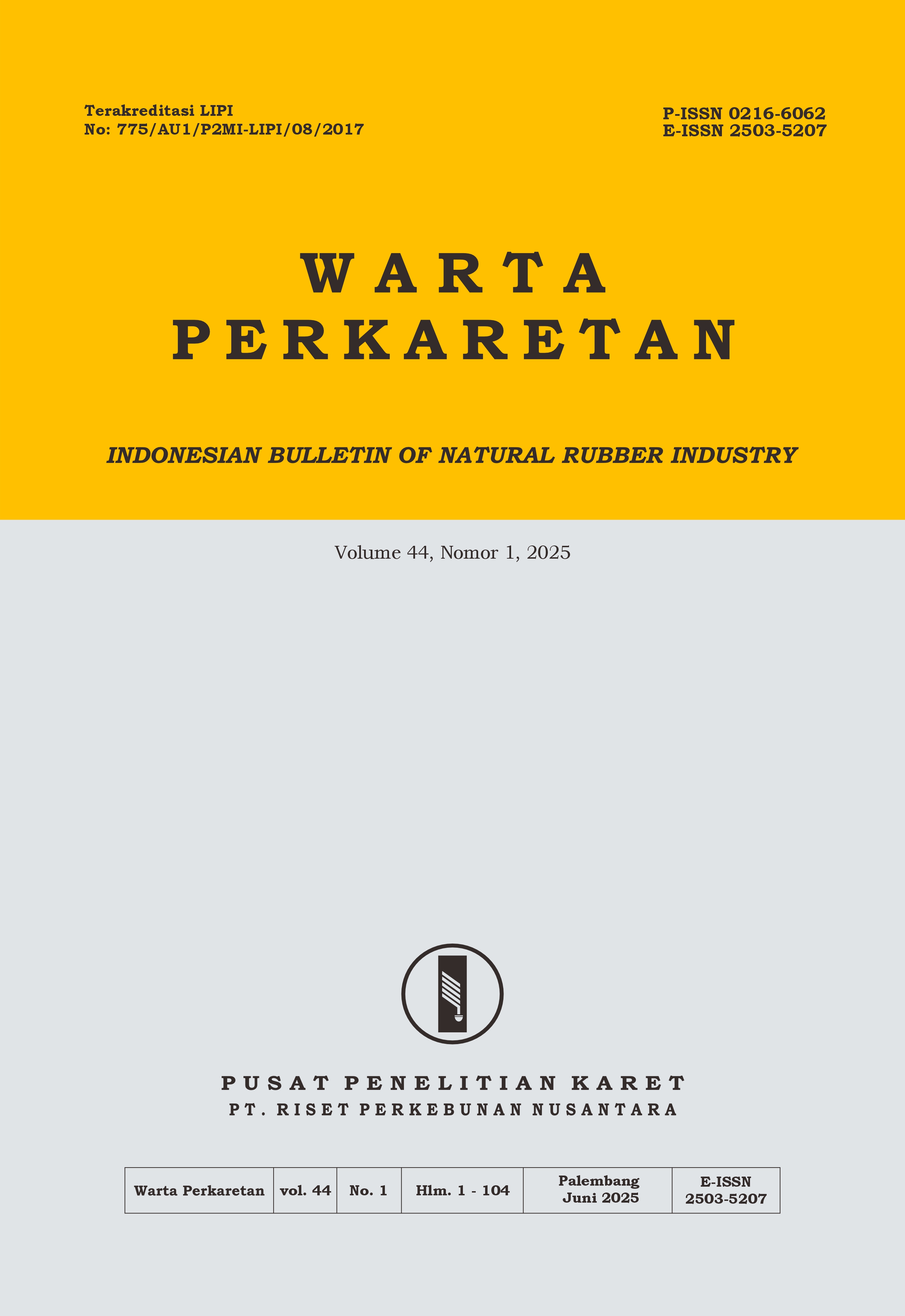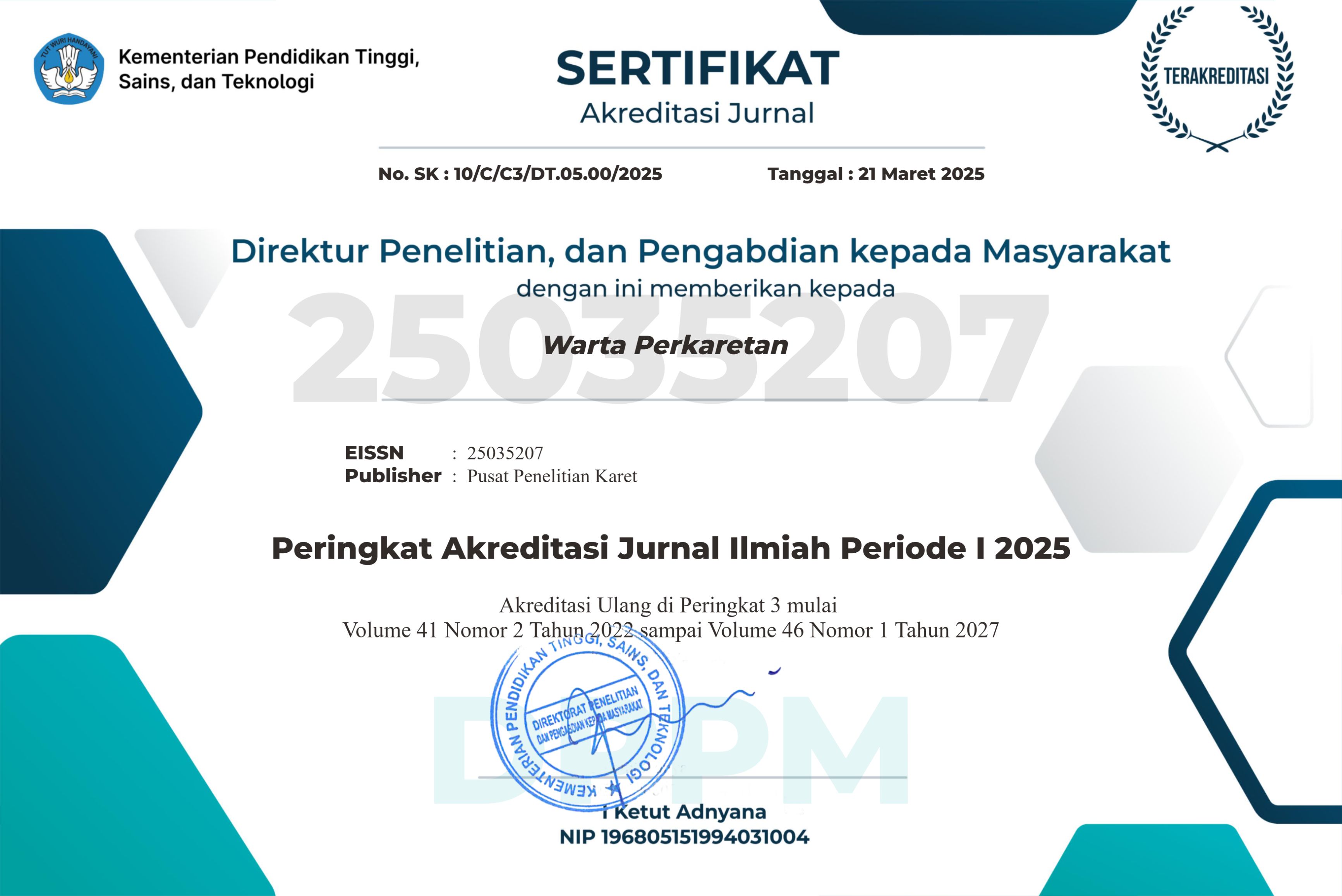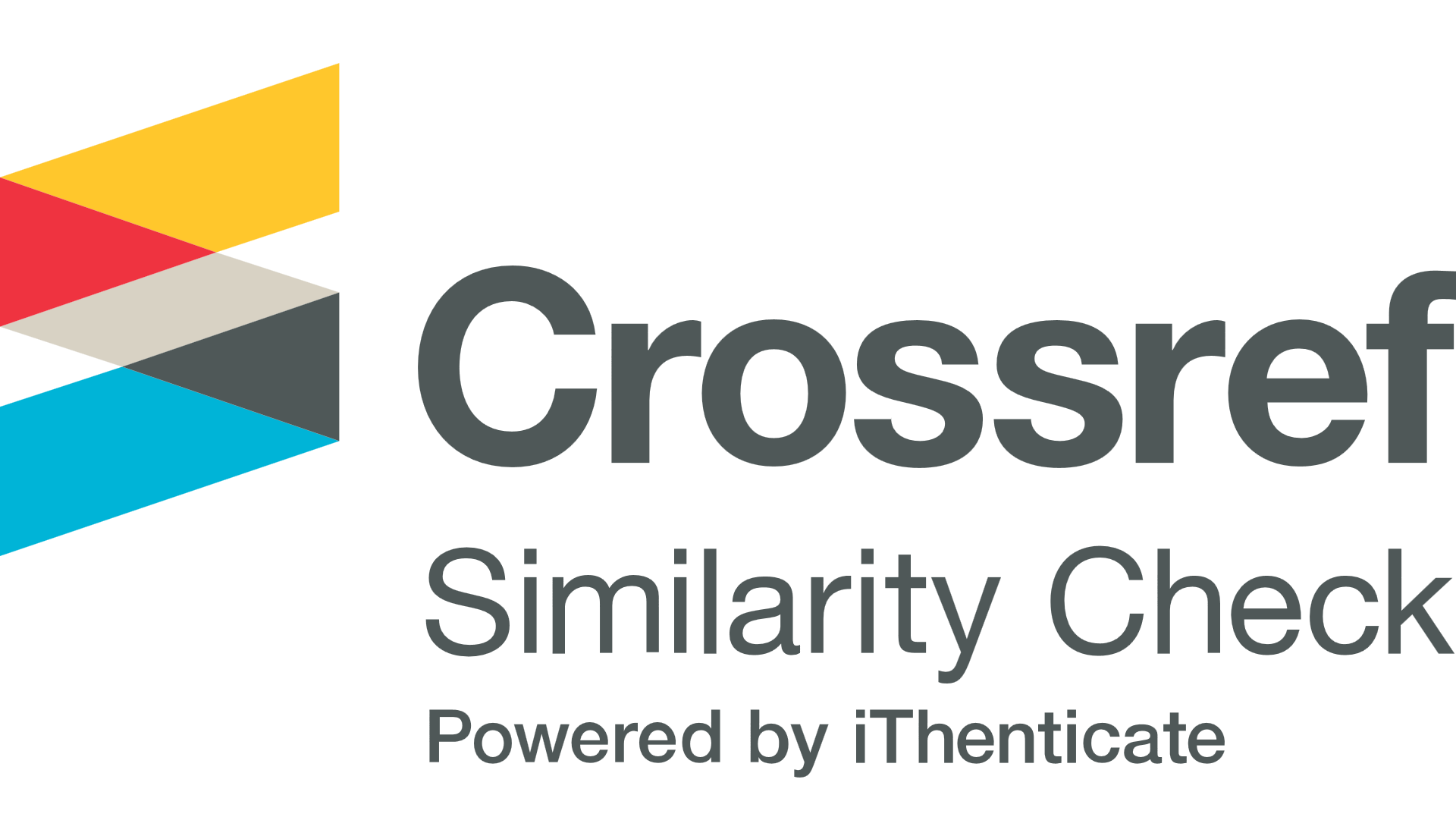PENGARUH JENIS PELARUT TERHADAP MODIFIKASI SELULOSA BAKTERI DENGAN SILANE Si69 SEBAGAI FILLER KARET ALAM
DOI:
https://doi.org/10.22302/ppk.wp.v44i1.1110Keywords:
filler ramah lingkungan, kompatibilitas selulosa-karet, silane coupling agent (Si69), FTIR, XRFAbstract
Karet alam banyak digunakan dalam berbagai industri, namun membutuhkan filler untuk meningkatkan sifat mekanik dan ketahanannya. Filler konvensional seperti karbon hitam dan silika memiliki kelemahan terkait dampak lingkungan dan berat jenis yang tinggi, sehingga diperlukan alternatif yang lebih ramah lingkungan. Selulosa bakteri merupakan kandidat potensial berkat kemurnian tinggi, kekuatan mekanik yang baik, dan sifat biodegradabilitasnya. Namun, perbedaan polaritas antara selulosa bakteri yang hidrofilik dan karet alam yang hidrofobik menjadi tantangan dalam aplikasinya, sehingga diperlukan modifikasi permukaan. Penelitian ini bertujuan untuk mengeksplorasi modifikasi selulosa bakteri menggunakan silane coupling agent Si69 dengan dua jenis pelarut, yaitu N,N-dimethylacetamide (DMAc) dan etanol, serta mengevaluasi efek variasi rasio selulosa bakteri terhadap silane (1/2, 1/4, 1/6, dan 1/8). Proses modifikasi dilakukan dengan mereaksikan selulosa bakteri dan silane dalam pelarut yang dipilih, kemudian hasilnya dikarakterisasi menggunakan Fourier Transform Infrared Spectroscopy (FTIR) dan X-Ray Fluorescence (XRF). Hasil FTIR menunjukkan kemunculan puncak baru pada 1242 cm⁻¹ (gugus Si–O–Si) dan 688 cm⁻¹ (gugus S–S atau C–S), sedangkan analisis XRF mengkonfirmasi keberadaan unsur silikon (Si) dan sulfur (S) pada selulosa bakteri yang telah dimodifikasi. Modifikasi dengan pelarut DMAc menghasilkan kandungan silikon dan sulfur yang lebih tinggi dibandingkan etanol, menunjukkan efektivitas modifikasi yang lebih baik. Formula optimum diperoleh pada rasio 1/8 BC/Si69 (DMAc). Studi ini memberikan dasar untuk pengembangan filler berbasis selulosa bakteri yang lebih kompatibel untuk aplikasi karet karet.
References
Abdallah Khalaf, E. S. (2023). A comparative study for the main properties of silica and carbon black Filled bagasse-styrene butadiene rubber composites. Polymers and Polymer Composites, 31, 09673911231171035. doi:10.1177/09673911231171035
Abdelmouleh, M., Boufi, S., ben Salah, A., Belgacem, M. N., & Gandini, A. (2002). Interaction of Silane Coupling Agents with Cellulose. Langmuir, 18(8), 3203-3208. doi:10.1021/la011657g
Agustin, Y. E., & Padmawijaya, K. S. (2018). Effect of Acetic Acid and Ethanol as Additives on Bacterial Cellulose Production by Acetobacter xylinum. IOP Conference Series: Earth and Environmental Science, 209(1), 012045. doi:10.1088/1755-1315/209/1/012045
Bindu Sharmila, T. K., Julie Chandra, C. S., Sasi., S., & Arundhathi, C. K. (2024). Modification of Cellulose. In S. Thomas, M. Hosur, D. Pasquini, & C. Jose Chirayil (Eds.), Handbook of Biomass (pp. 535-571). Singapore: Springer Nature Singapore.
Çakar, F., Özer, I., Aytekin, A. Ö., & ?ahin, F. (2014). Improvement production of bacterial cellulose by semi-continuous process in molasses medium. Carbohydrate Polymers, 106, 7-13. doi:https://doi.org/10.1016/j.carbpol.2014.01.103
Fuller, M. E., Andaya, C., & McClay, K. (2018). Evaluation of ATR-FTIR for analysis of bacterial cellulose impurities. Journal of Microbiological Methods, 144, 145-151. doi:https://doi.org/10.1016/j.mimet.2017.10.017
Hamimed, S., Abdeljelil, N., Landoulsi, A., Chatti, A., Aljabali, A. A. A., & Barhoum, A. (2020). Bacterial Cellulose Nanofibers. In A. Barhoum (Ed.), Handbook of Nanocelluloses: Classification, Properties, Fabrication, and Emerging Applications (pp. 1-38). Cham: Springer International Publishing.
Ismail, H., Shuhelmy, S., & Edyham, M. R. (2002). The effects of a silane coupling agent on curing characteristics and mechanical properties of bamboo fibre filled natural rubber composites. European Polymer Journal, 38(1), 39-47. doi:https://doi.org/10.1016/S0014-3057(01)00113-6
Jantachum, P., Khumpaitool, B., & Utara, S. (2023). Effect of silane coupling agent and cellulose nanocrystals loading on the properties of acrylonitrile butadiene rubber/natural rubber nanocomposites. Industrial Crops and Products, 195, 116407. doi:https://doi.org/10.1016/j.indcrop.2023.116407
Jiang, H., Zheng, Z., Li, Z., & Wang, X. (2006). Effects of Temperature and Solvent on the Hydrolysis of Alkoxysilane under Alkaline Conditions. Industrial & Engineering Chemistry Research, 45(25), 8617-8622. doi:10.1021/ie0607550
Kahawita, H., Samarasekara, A., Amarasinghe, D. A. S., & Karunanayake, L. (2020). Nanofibrillated Cellulose Reinforced Polypropylene Composites: Influence Of Silane (Si-69) Surface Modification. Cellulose Chemistry and Technology, 54, 789-797. doi:10.35812/CelluloseChemTechnol.2020.54.78
Klemm, D., Kramer, F., Moritz, S., Lindström, T., Ankerfors, M., Gray, D., & Dorris, A. (2011). Nanocelluloses: a new family of nature-based materials. Angew Chem Int Ed Engl, 50(24), 5438-5466. doi:10.1002/anie.201001273
Kono, H., Uno, T., Tsujisaki, H., Matsushima, T., & Tajima, K. (2020). Nanofibrillated Bacterial Cellulose Modified with (3-Aminopropyl)trimethoxysilane under Aqueous Conditions: Applications to Poly(methyl methacrylate) Fiber-Reinforced Nanocomposites. ACS Omega, 5(45), 29561-29569. doi:10.1021/acsomega.0c04533
Lahiri, D., Nag, M., Dutta, B., Dey, A., Sarkar, T., Pati, S., . . . Ray, R. R. (2021). Bacterial Cellulose: Production, Characterization, and Application as Antimicrobial Agent. Int J Mol Sci, 22(23). doi:10.3390/ijms222312984
Li, X. D., Lan, A., Tang, J. W., Zhang, Y., Gibril, M. E., & Yu, M. H. (2015). Effects of Polar Aprotic Solvents on Dissolving Cellulose in Ionic Liquid. Advanced Materials Research, 1073-1076, 282-285. doi:10.4028/www.scientific.net/AMR.1073-1076.282
Mishra, S., Singh, P. K., Pattnaik, R., Kumar, S., Ojha, S. K., Srichandan, H., . . . Sarangi, P. K. (2022). Biochemistry, Synthesis, and Applications of Bacterial Cellulose: A Review. Frontiers in Bioengineering and Biotechnology, Volume 10 - 2022. doi:10.3389/fbioe.2022.780409
Moon, R. J., Martini, A., Nairn, J., Simonsen, J., & Youngblood, J. (2011). Cellulose nanomaterials review: structure, properties and nanocomposites. Chemical Society Reviews, 40(7), 3941-3994. doi:10.1039/C0CS00108B
Murakami, K., Iio, S., Ikeda, Y., Ito, H., Tosaka, M., & Kohjiya, S. (2003). Effect of silane-coupling agent on natural rubber filled with silica generated in situ. Journal of Materials Science, 38(7), 1447-1455. doi:10.1023/A:1022908211748
Nawaz, H., Zhang, J., Tian, W., Wu, J., & Zhang, J. (2019). Chemical Modification of Cellulose in Solvents for Functional Materials. In B. Han & T. Wu (Eds.), Green Chemistry and Chemical Engineering (pp. 427-460). New York, NY: Springer New York.
Oksman, K., Mathew, A. P., Bondeson, D., & Kvien, I. (2006). Manufacturing process of cellulose whiskers/polylactic acid nanocomposites. Composites Science and Technology, 66(15), 2776-2784. doi:https://doi.org/10.1016/j.compscitech.2006.03.002
Pogorelova, N., Rogachev, E., Digel, I., Chernigova, S., & Nardin, D. (2020). Bacterial Cellulose Nanocomposites: Morphology and Mechanical Properties. Materials (Basel), 13(12). doi:10.3390/ma13122849
Rahmayetty, Meri, y., Muhamad, T., & Nufus, K. (2022, 2022/12/24). The Effect of Acetobacter xylinum Concentration to Bacterial Cellulose Production Using Waste Water of Palm Flour Industry as Fermentation Medium. Paper presented at the Proceedings of the 2nd International Conference for Smart Agriculture, Food, and Environment (ICSAFE 2021).
Raut, M. P., Asare, E., Syed Mohamed, S. M. D., Amadi, E. N., & Roy, I. (2023). Bacterial Cellulose-Based Blends and Composites: Versatile Biomaterials for Tissue Engineering Applications. International Journal of Molecular Sciences, 24(2), 986. Retrieved from https://www.mdpi.com/1422-0067/24/2/986
Sae-oui, P., Sirisinha, C., Hatthapanit, K., & Thepsuwan, U. (2005). Comparison of reinforcing efficiency between Si-69 and Si-264 in an efficient vulcanization system. Polymer Testing, 24(4), 439-446. doi:https://doi.org/10.1016/j.polymertesting.2005.01.008
Setiawan, A., Anggraini, F. D. M., Ramadani, T. A., Cahyono, L., & Rizal., M. C. (2021). Pemanfaatan Jerami Padi Sebagai Bioplastik Dengan Menggunakan Metode Perlakuan Pelarut Organik. Metana: Media Komunikasi Rekayasa Proses dan Teknologi Tepat Guna 17(2), 69-80. doi: 10.14710/metana.v17i2.42254
Spahr, M. E., & Rothon, R. (2017). Carbon Black as a Polymer Filler. In R. Rothon (Ed.), Fillers for Polymer Applications (pp. 261-291). Cham: Springer International Publishing.
Taokaew, S., Ofuchi, M., & Kobayashi, T. (2019). Size Distribution and Characteristics of Chitin Microgels Prepared via Emulsified Reverse-Micelles. Materials, 12(7), 1160. Retrieved from https://www.mdpi.com/1996-1944/12/7/1160
Thomas, S. K., Parameswaranpillai, J., Krishnasamy, S., Begum, P. M. S., Nandi, D., Siengchin, S., . . . Sienkiewicz, N. (2021). A comprehensive review on cellulose, chitin, and starch as fillers in natural rubber biocomposites. Carbohydrate Polymer Technologies and Applications, 2, 100095. doi:https://doi.org/10.1016/j.carpta.2021.100095
Umamaheswari, S., S. Malkar Oli, & Naveena., K. (2017). FTIR Spectral and Microarchitectural Analysis of Cellulose Produced by Lactococcus lactis Under Agitated Condition. Journal of Pure and Applied Microbiology, 11(4), 1965-1971. doi:doi: 10.22207/JPAM.11.4.38
Wu, W., & Chen, F. (2020). Interfacial Modification of Corn Stalk Cellulose Reinforced Used Rubber Powder Composites Treated with Coupling Agent. Journal of Renewable Materials, 8(8), 905--913. Retrieved from http://www.techscience.com/jrm/v8n8/39497
Zhong, C. (2020). Industrial-Scale Production and Applications of Bacterial Cellulose. Frontiers in Bioengineering and Biotechnology, Volume 8 - 2020. doi:10.3389/fbioe.2020.605374
Downloads
Published
How to Cite
Issue
Section
License
Copyright (c) 2025 Mili Purbaya

This work is licensed under a Creative Commons Attribution-NonCommercial-ShareAlike 4.0 International License.
Submission of a original research or review articles in Warta Perkaretan implies that the submitted  manuscript has not been published in any scientific journal (except being part of the abstract, thesis, or report). The submitted manuscript also is not under consideration for publication elsewhere. All co-authors involve in the publication of the manuscript should give their approval. Once, the manuscript is accepted and then published in Warta Perkaretan, the Author(s) keep hold the copyright and retain publishing right without restrictions. Author(s) and Warta Perkaretan users are allowed to multiply the published manuscript as long as not for commercial purposes. The journal users are also permissible to share the published manuscript with an acknowledgement to the Author(s). The Editorial Boards suggest that the Authors should manage patent before publishing their new inventions.







